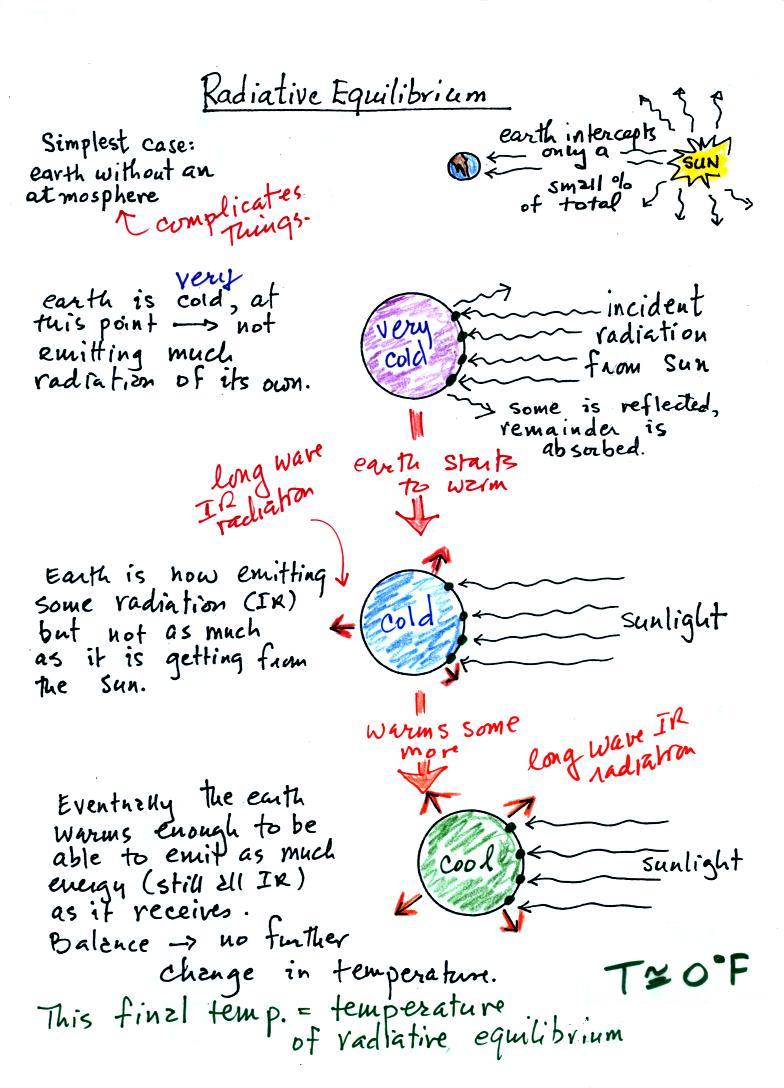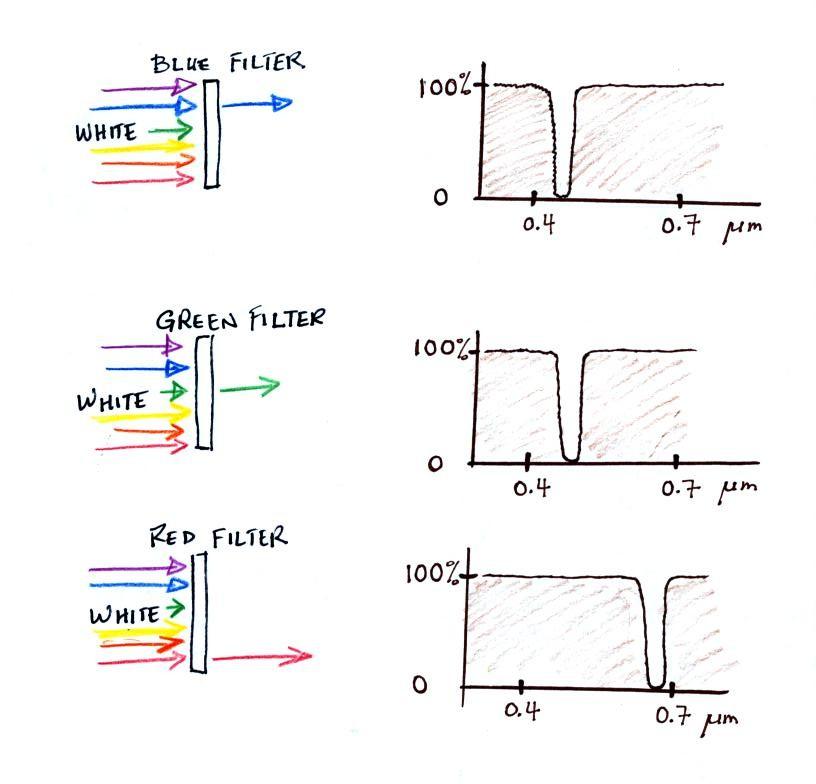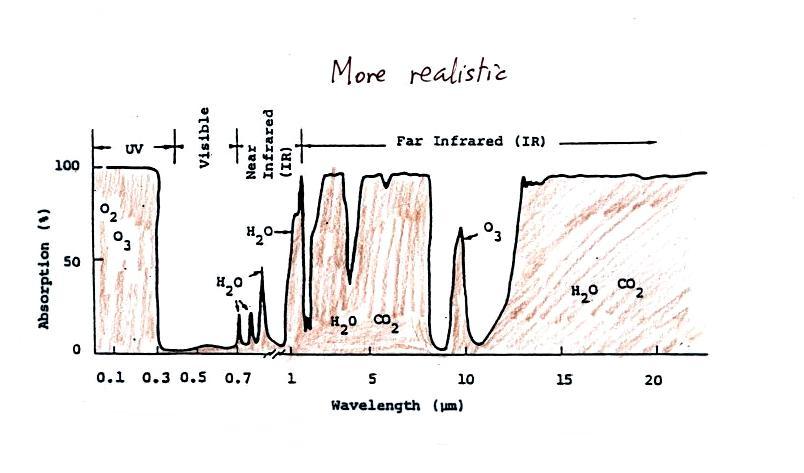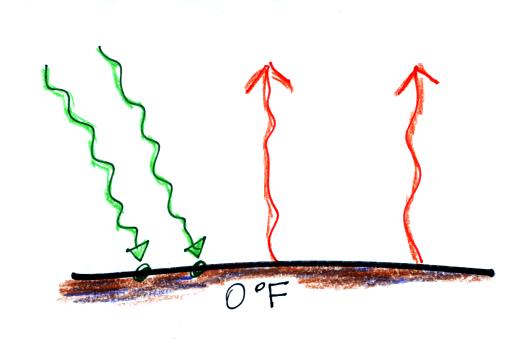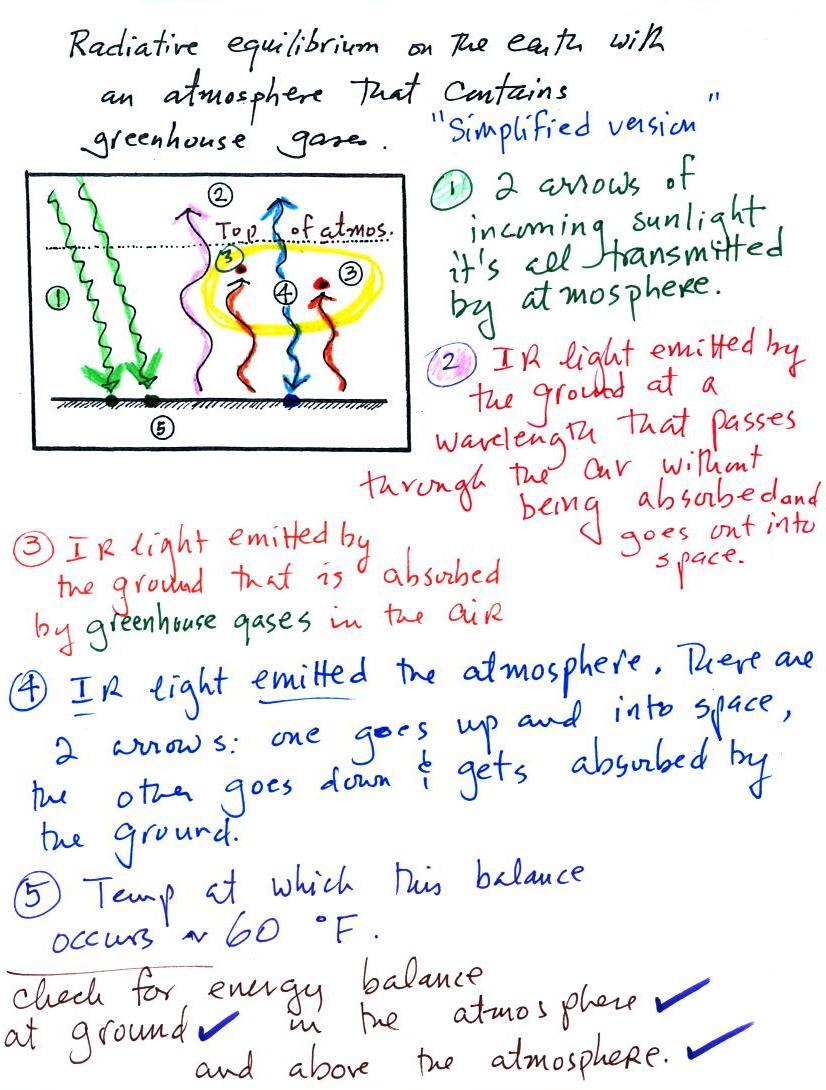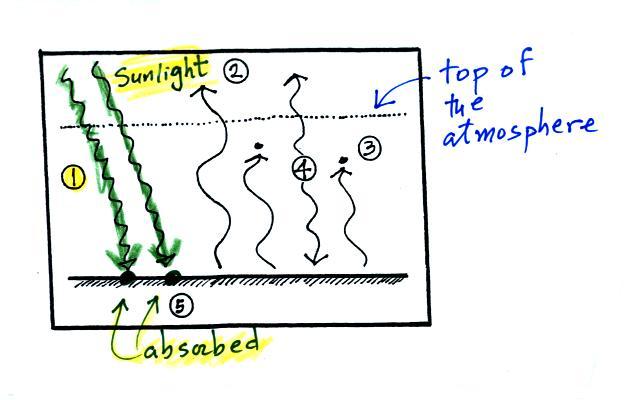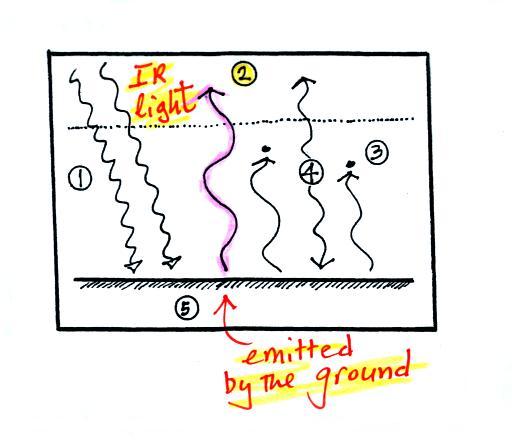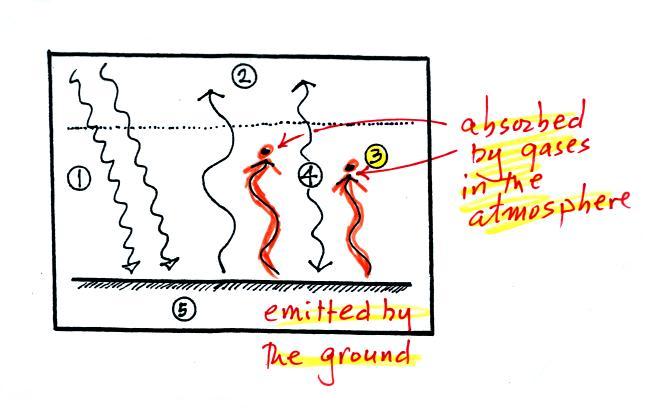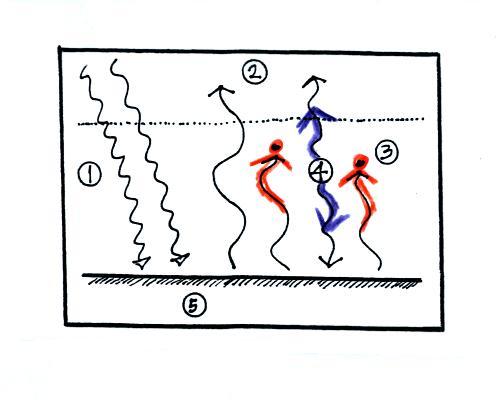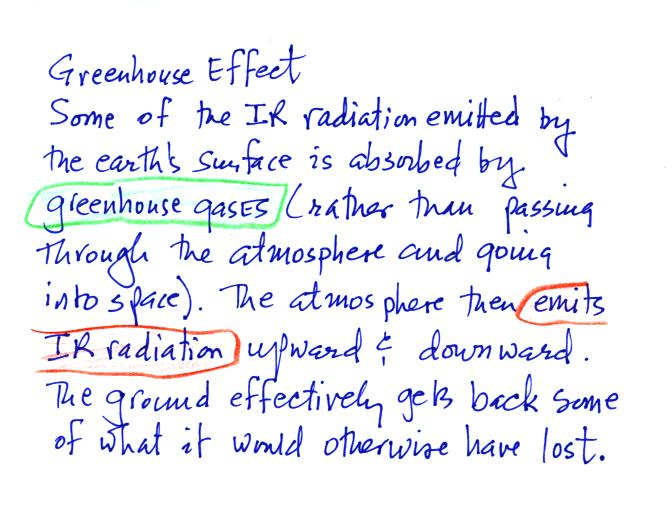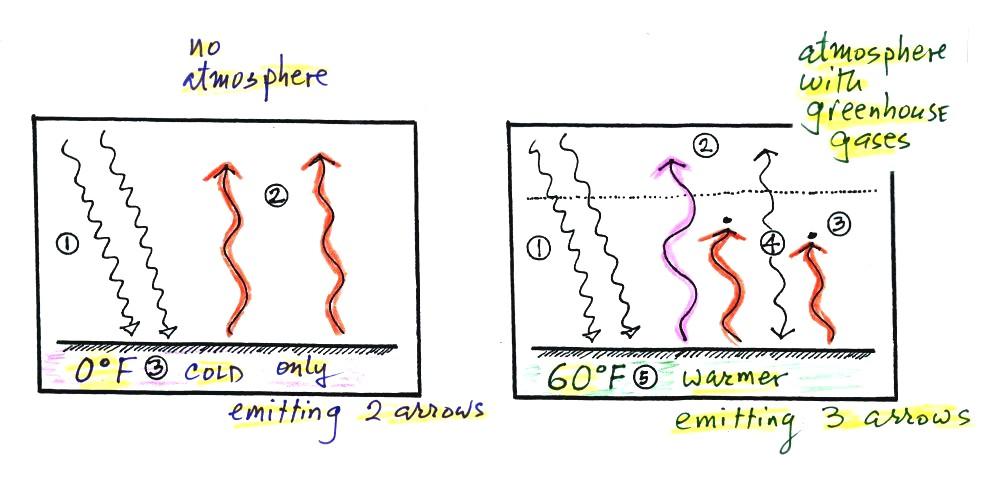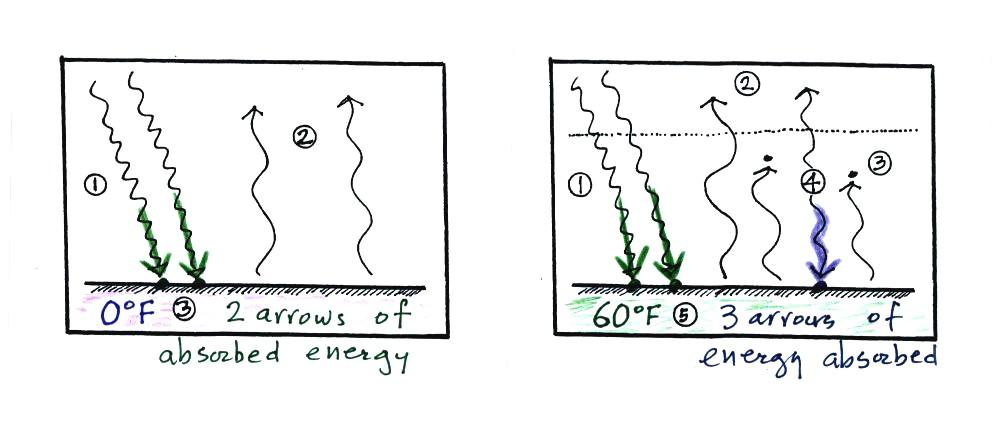We now
have most of the tools we will need to begin to study energy balance on
the earth. It will be a balance between incoming sunlight
energy and outgoing energy emitted by the earth. We will look at
the simplest case first, the earth without an atmosphere (or at least
an atmosphere without greenhouse gases).
You might first wonder how, with
the sun emitting so much
more
energy than the earth, it is possible for the earth (with a temperature
of around 300 K) to be in energy
balance with the sun (6000 K). At the top right of the figure you
can see that the earth is located about 90
million miles
from the sun and therefore only absorbs a very small fraction of the
total energy emitted by the sun. The earth really only needs to
emit a very small fraction of what the sun emits to be in balance.
To understand how energy balance occurs we start, in Step #1, by
imagining that the earth starts out with a temperature of absolute zero
(0 K) and is
not emitting
any EM radiation at all. It is absorbing sunlight however so it
will
begin to warm. This is like opening a bank account, the initial
balance
will be zero. But then you start making deposits and the balance
starts to grow.
Once the earth starts to warm it will also begin to emit EM
radiation, though not as much as it is getting from the sun (the
slightly warmer earth in the middle picture is now colored blue).
Once you find money in your bank account you start to spend it.
Because the earth is still gaining more energy than it is losing the
earth will warm some more.
Eventually it will warm enough that the earth (now shaded green)
will
emit the same amount
of energy (though not at the same wavelength) as it absorbs from
the sun. This is radiative equilibrium, energy balance. The
temperature at
which this occurs is about 0 F.
That is called the temperature of radiative equilibrium. You
might remember this is the figure for global annual average surface
temperature on the earth without the greenhouse effect.
Before we
start to look at radiant energy balance on the earth with an atmosphere
we
need to learn about filters. The atmosphere will filter sunlight
as it
passes through the atmosphere toward the ground. The atmosphere
will
also filter IR radiation emitted by the earth as it trys to travel into
space.
We will first look at the effects simple blue, green, and red glass
filters have on visible light. This is just to become familiar
with filter absorption graphs.
If you try to
shine white light (a
mixture of all the colors) through a
blue filter, only the blue light passes through. The filter
absorption curve shows 100% absorption at all but a narrow range of
wavelengths that correspond to blue light. Similarly the green
and red filters only let through green and red light.
The following figure is a simplified, easier to
remember,
representation of the
filtering effect of
the atmosphere on UV, VIS, and IR light.
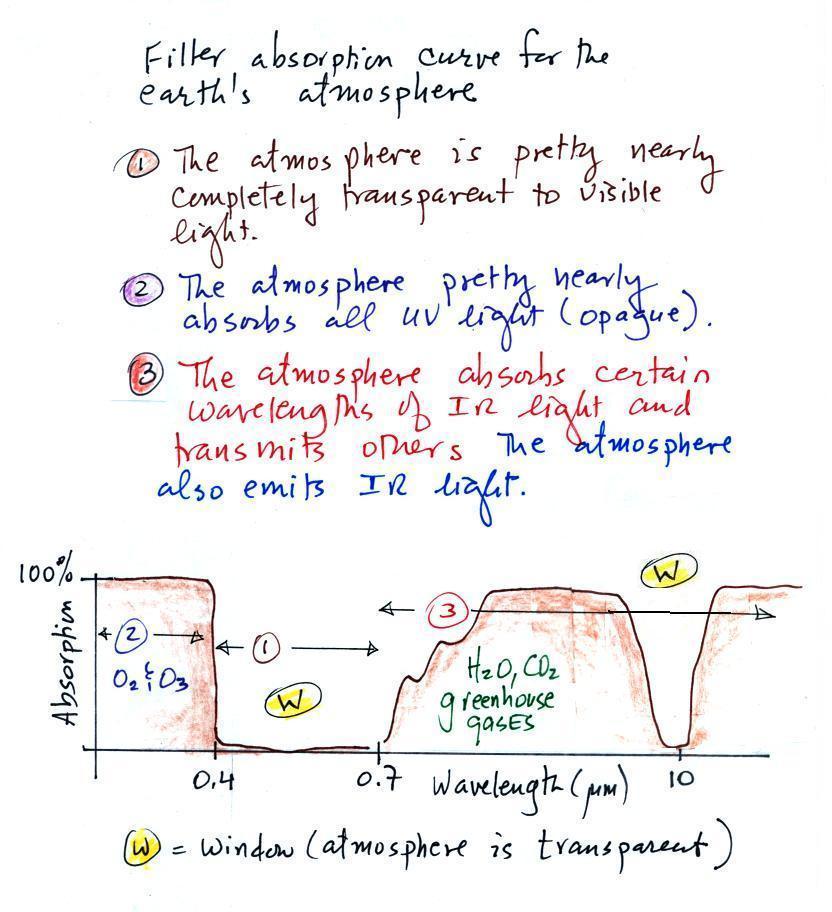
You can use your own eyes to tell
you what the filtering
effect of the
atmosphere is on visible light. Air is clear, it is
transparent. The atmosphere transmits visible light.
In our simplified representation oxygen and ozone make the
atmosphere pretty nearly completely opaque to UV light . We
assume that the
atmosphere absorbs all incoming UV light, none of it makes it to the
ground. This is, of course, not entirely accurate.
Greenhouse gases make the
atmosphere a
selective absorber of IR light - the air absorbs certain IR wavelengths
and
transmits others. It is the atmosphere's ability to absorb (and
also emit) certain wavelengths of infrared light that produces the
greenhouse effect and warms the surface of the earth.
Note "The atmospheric window"
centered at 10 micrometers. Light emitted by the earth at this
wavelength (and remember 10 um is the wavelength of peak emission for
the earth) will pass through the atmosphere. Another transparent
region, another window, is found in the visible part of the spectrum.
A more realistic picture of the atmospheric absorption
curve is shown below. The simplified
version above will work fine for us.
Now back to radiative
equilibrium. Here's the
outer space view on the earth without an
atmosphere. The important thing to note is that the earth is
absorbing and emitting the same amount of energy (4 arrows absorbed
balanced by 4 arrows emitted).
We will be moving from an outer
space vantage point of
radiative equilibrium (figure above) to the earth's
surface (figure below).
Don't let the fact that there are
4 arrows are
being absorbed and
emitted in the top figure and
2 arrows absorbed and emitted in the bottom figure
bother you. The important thing is that there are equal
amounts being absorbed and emitted in both cases.
The next
step is to add the atmosphere.
The figure below is a simplified
version
of radiative equilibrium on the earth with an atmosphere. This
will be easier to understand.
We'll examine the various parts of this figure individually.
1. The
figure shows two
rays of incoming sunlight that
pass through the atmosphere, reach the ground, and are absorbed.
100% of the incoming sunlight is transmitted by the atmosphere.
This wouldn't be too bad of an assumption if sunlight were just visible
light. But sunlight is about half IR light and some of that
is going to be absorbed.
The ground is emitting
3 rays of IR radiation.
2. One
of
these
(pink
arrow
above)
is
emitted
by
the ground at a wavelength
that is
NOT absorbed by greenhouse gases in the atmosphere. This
radiation passes through the atmosphere and goes out into space.
3. The other 2
units of IR radiation emitted by
the
ground are
absorbed by
greenhouse gases is the atmosphere.
4. The
atmosphere is absorbing
2 units of radiation.
In order to be in radiative equilibrium,the atmosphere must also emit 2
units of radiation. 1
unit of IR radiation is sent upward into space, 1 unit is sent downward
to the ground where it is absorbed.
Before we go any further we will
check
to be sure that
every part
of this picture is in energy balance.
The ground is absorbing
3 units of energy (2 green
arrows of sunlight and one bluish arrow coming from the atmosphere) and
emitting
3
units of energy (one pink and two red arrows)
The atmosphere is
absorbing 2 units of energy and
emitting 2
units of
energy
2 units of energy
arrive at the earth from outer
space, 2 units
of
energy leave the earth and head back out into space.
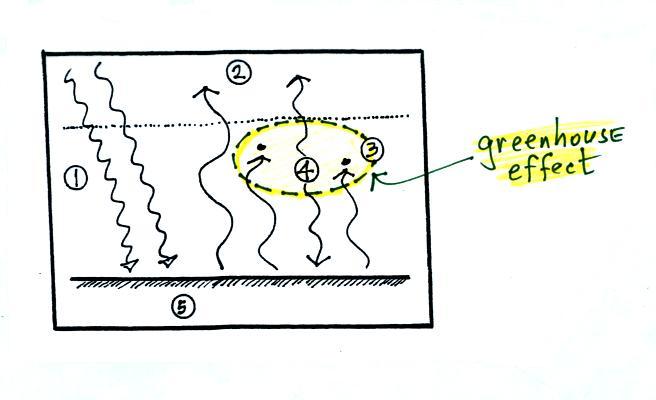
The greenhouse effect
is found in the absorption and
emission
of IR radiation by the atmosphere. Here's how you might put it
into words:
The greenhouse effect warms the
surface of the earth. The next two figures explain why
this is so.
Energy balance without
an atmosphere (left) and with an atmosphere that contains greenhouse
gases (right) the
greenhouse
effect. At left the ground is emitting 2 units of energy, at
right the ground is emitting 3 units. Remember that the amount of
energy emitted by something depends on temperature. The ground
in the right picture must be warmer to be able to emit 3 arrows of
energy rather than 2
arrows.
Here's another
explanation.
At left the ground
is getting 2 units of energy (from the sun). At right it is
getting three, two from the sun and one from the atmosphere.
Doesn't it seem
reasonable
that ground that absorbs 3 units of energy will be warmer than ground
that is only absorbing 2?
